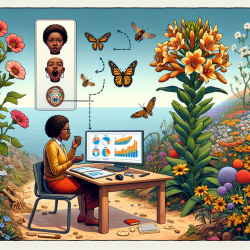Introduction
In the world of speech-language pathology, data-driven decisions are paramount. We rely on research to inform our practices and improve outcomes for children. Interestingly, lessons can be drawn from seemingly unrelated fields, such as botany. The recent study, "Intrafloral patterns of color and scent in Capparis spinosa L. and the ghosts of its selection past," provides insights that can be translated into the realm of speech therapy.
Understanding the Research
The study explores the floral evolution of Capparis spinosa, a plant with a mixed pollination system involving bees and hawkmoths. Despite its nocturnal flowering habits, the plant attracts more diurnal bees than nocturnal hawkmoths. This paradox is explained by the plant's sensory cues, including scent and color patterns, which are tailored to attract a diverse range of pollinators.
Lessons for Speech Therapists
So, what can speech therapists learn from this botanical study? Here are a few takeaways:
- Diversification of Strategies: Just as Capparis spinosa employs a range of sensory cues to attract different pollinators, speech therapists can diversify their strategies to engage children with varying needs. By using a mix of visual, auditory, and tactile stimuli, therapists can cater to the unique sensory preferences of each child.
- Adapting to Inconsistencies: The plant's ability to attract inconsistent pollinators like hawkmoths highlights the importance of flexibility. In speech therapy, practitioners must be adaptable, ready to modify approaches based on the child's response and progress.
- Resource Allocation: The study reveals that Capparis spinosa allocates resources efficiently to maintain its floral display. Similarly, speech therapists should prioritize resources, focusing on interventions that yield the greatest benefit for the child's development.
Encouraging Further Research
The study of Capparis spinosa opens the door to further research opportunities. Speech therapists can explore how sensory stimuli influence engagement and learning in children. By understanding the sensory preferences of each child, therapists can tailor interventions to maximize effectiveness.
Conclusion
While the study of Capparis spinosa may seem distant from speech therapy, it offers valuable insights into the importance of diversification, adaptability, and resource allocation. By applying these principles, speech therapists can enhance their practice and improve outcomes for children.
To read the original research paper, please follow this link: Intrafloral patterns of color and scent in Capparis spinosa L. and the ghosts of its selection past.










